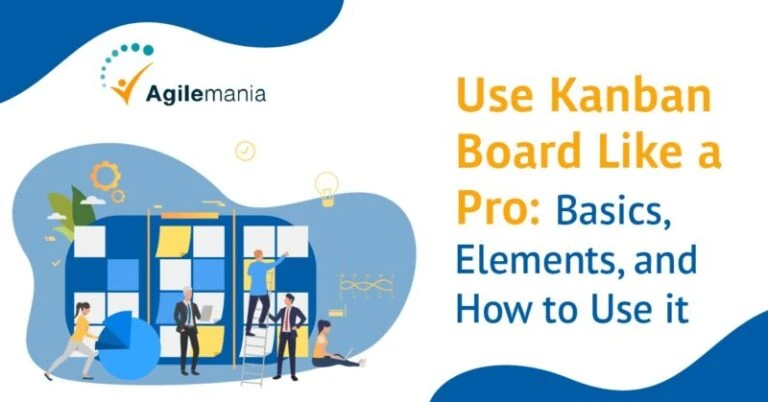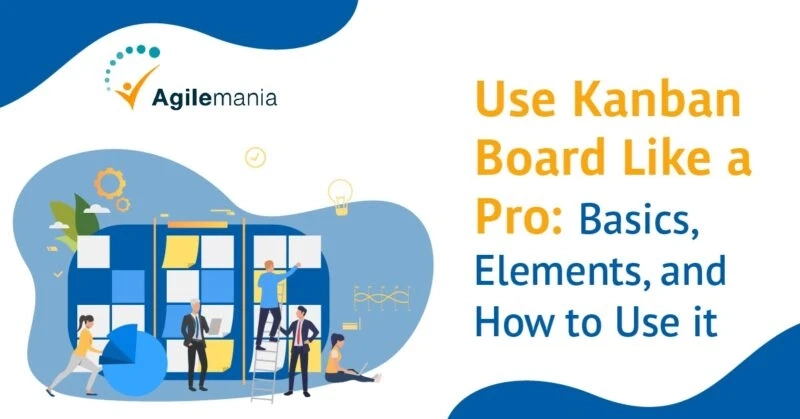
If you are familiar with agile methodologies, then Kanban makes it to the top tier. While organizations small and big have used Kanban and seen phenomenal results.
If you’re a beginner looking to know what a Kanban board is, the basics, elements, and how to use it, then here’s a descriptive guide that we’ve compiled so that you shouldn’t have to scour the internet for research.
Let’s jump right in!
What is Kanban Board?
A Kanban Board is an agile project management tool created to help envision workflow in your organization. It is a tool to help limit work-in-progress and optimize efficiency.
Elements of a Kanban board
Kanban boards help visualize the workflow. But how? The Kanban Board has elements that help do it. There are four elements in the Kanban board-
- Kanban Cards: Kanban cards are the visual representation of tasks. Every card contains details of the task such as deadline, assignee, description, and the like.
- Kanban Columns: The Kanban columns represent different stages of the workflow. The cards which represent tasks go through different columns until they reach closure. The stages in the workflow can be ‘To do, Work-in-progress, ‘Complete.’
- Work-In-Progress Limits: Work-In-Progress Limits are the number of cards a column can have at one time. For example, no Column can have more than three cards at one time. It is to ensure that the workflows don’t have to be clogged with too many in-progress tasks. The WIP limits ensure that the team can focus on the tasks that are underway. This helps in clearing congestion in the workflow.
- Kanban Swimlanes: Kanban Swimlanes are rows used to group tasks on a Kanban board. Swimlanes can be used to increase productivity in the following ways-
- Create tasks in the order of priority
- Balancing team allocation optimally
- Handling tasks based on user stories and phases
How to use a Kanban Board
Kanban Boards might seem complicated given the above information, but it isn’t.
Start a Kanban board by creating a simple structure and improve it by following the below steps-
- Identify workflow hurdles on the Kanban Board: There isn’t any better tool like Kanban to visualize workflow and spot hurdles in the workflow easily. Here’s a simple tip! If you find any column with many tasks that arrive when they reach completion, the work starts to mount, and the team is burdened. The cause could be a minor problem that can be resolved quickly. One way to make the workflow more efficient is to label the columns with details of the task progress. In addition, limiting the number of tasks in the workflow will ensure that the team is devoting their time to tasks that matter.
The Kanban offers flexibility to distribute the team’s efforts on tasks that need immediate attention.
- Limit WIP and focus using the Kanban board: Kanban can help the team to take on tasks that they can complete. By setting work in progress limits in one column, you will limit the tasks in progress. By limiting tasks, the team will only take on new tasks once they are finished with the previous tasks. So, if customer satisfaction, faster time to market, productivity, and profitability are your goals, work on current tasks instead of having backlogs.
- Save time on unproductive and unnecessary meetings: A golden benefit of using a Kanban board is that it helps you save your precious time on pointless meetings, meaningless reports, and other unproductive discussions. The board will keep the stakeholders informed about the progress of the tasks. This ensures that they are kept in the loop of any developments or problems that the team encounters while working on the project. This saves you countless hours spent on unnecessary meetings and progress reports that take forever to prepare.
- Visualize the work obstacles on your Kanban board: The Kanban board allows you to make a mental map of the work obstacles that prevent the team from progressing. The hurdles can be easily marked on a physical or digital Kanban board. This helps you correct and remove the hindrances to work your way to success. For example, in the case of a digital Kanban board, the team can mark the obstacle as blocked and work on another task without increasing the WIP limit.
- Automate work processes on the Kanban board: Do you find yourself tired of doing repetitive tasks manually and hope to have an easy alternative instead? Kanban boards have become automated these days. Teams have to deal with repetitive tasks, inform teammates about changes, fix reminders about approaching deadlines, and smooth handover of responsibilities. This takes up more time than necessary. New Kanban boards allow you to automate the workflow and set triggers for fixed events. This ensures greater efficiency, improved productivity by minimizing wasteful activities.
- Track important workflow metrics and make progress: Digital Kanban works in real-time and collects data related to lead time, cycle time, and other important metrics. This will enable you to make data-driven decisions and take measures to improve the workflow. The charts help you track workflow delivery and improve task or project delivery.
Learn how to apply Kanban practices to Scrum with Professional Scrum with Kanban(PSK) Training
To view the full blog and this blog "How to use kanban board" is originally published on Agilemania website.
0


